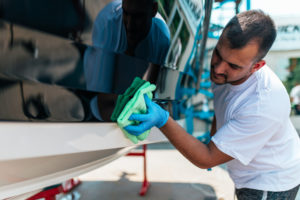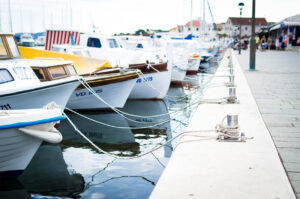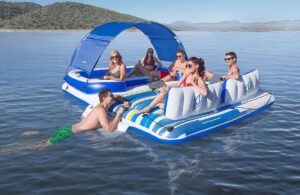It’s the most wonderful time of the year, spring cleaning! Whether starting a boating season or enjoying the middle of year-round boating, the task of cleaning is inevitable. A clean boat is good, but a lot of products and processes can be environmentally harmful. Here are eco-friendly boating techniques to protect the environment and your vessel.
It’s a Wrap – Eco-friendly boating shrink wrap
Many boaters begin spring cleaning by unwrapping their boats. Shrink wrapping, a method of protecting stored boats from the elements, involves using a large sheet of plastic, which conforms to the shape of a vessel when heated. It is extremely popular with boat owners, boat yards and marinas.
Marine grade shrink wrap is made up of a high-gauge polyethylene that does not do well in landfills. Not only is it long lived, but it takes up a lot of space. Conservative estimates put the amount of shrink wrap used by U.S. boaters at up to 20,000 tons per year. That’s a lot when you consider most of the wrap enters landfills around the same time each year.
U.S. marinas, boatyards and municipalities are partnering with other organizations to provide recycling options. One example is the Marine Trade Association of Maryland’s shrink-wrap recycling program. Working with more than 25 marinas, the Clean Marina Program and Chesapeake Materials, succeeded in keeping about 30,000 pounds of wrap out of Maryland landfills in 2019.
According to Susan Zellers, executive director of the Marine Trade Association of Maryland, one of the biggest hurdles in a successful program is preparing the discarded wrap, which is an issue for similar recycling programs throughout the states.
Wrap intended for recycling must be free of zippers, straps, vents and doors before it is bagged or rolled, depending on your local program’s requirements. Many marinas involved with the Clean Marina program will offer or facilitate wrap recycling. As you prepare to unwrap your boat, ask your boatyard or marina if they offer recycling.
Location, Location, Location

When doing dishes at home, detergent- filled wastewater travels through a treatment system that allows time for chemicals to break down before entering the environment. This is not the case when it comes to washing boats. Marine ecosystems are near or directly below the boat hull. This short distance means a reduced timeline for products to break down. Even eco-friendly biodegradables require time to degrade. If possible, clean your boat while it is out of the water and take advantage of properly drained washdown areas in the marina or boat yard.
If cleaning while afloat, you can still limit your environmental impact. Follow dilution instructions for all cleaners, even those deemed safe for the environment. If toxic solutions are needed, use as spot treatments and wipe residue away instead of rinsing into the water. When cleaning below the waterline, be aware of surrounding water flow. Even brushing off organic growth can create significant silting and imbalance in an ecosystem. Cleaning your boat on an out-going tide allows soaps and residue to be carried away from shore.
Rub-A-Dub-Dub
Whether you are giving your boat a washdown after a winter slumber on the hard or swabbing the deck of an in-water vessel, your cleaner will find its way to the environment. Detergents contain mixtures of synthetic chemicals, including a special type known as a surfactant, which help water seep into spaces, grab hold, and break up dirt and grease to be washed away.
What makes detergents effective is also what makes them environmental concerns. Surfactants can attach to the natural oils of fish and hinder gill function. Some phosphate-containing detergents promote algae blooms when leeched into fresh water, resulting in lower oxygen content for aquatic life.
Finding the most effective product with the least impactful ingredients is a worthwhile challenge. Labels can be confusing. No federal standards or requirements label products “biodegradable” or “environmentally safe.” While manufacturers must support their claims in a scientific manner, it is best to read ingredients and not just label claims. One helpful label is the Environmental Protection Agency’s Safer Choice. This program allows use of its logo on products made with chemicals deemed least hazardous to the environment.
Product testing and reviews are also valuable resources for finding the best balance for your cleaning needs. The Environmental Working Group (EWG), a nonprofit organization, provides an easy-to-navigate rating guide of cleaners. EWG’s Guide to Healthy Cleaning is based on comparisons of product ingredients, toxicity databases, environmental studies and literature. Other options include DIY recipes of ingredients such as vinegar, baking soda and lemon juice, which are used to replace everything from general cleaners to metal polishers.
The most wonderful time of the year for boaters is also the most wonderful time to make environmentally friendly choices.





